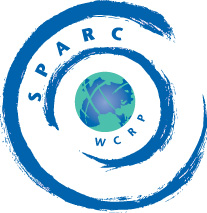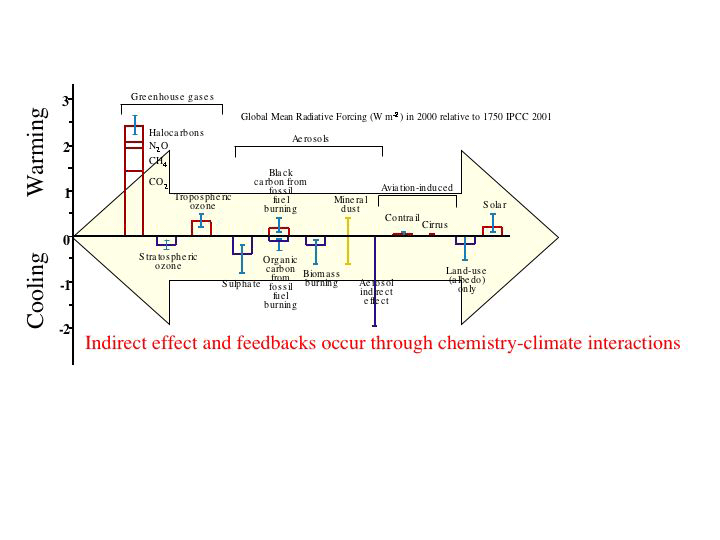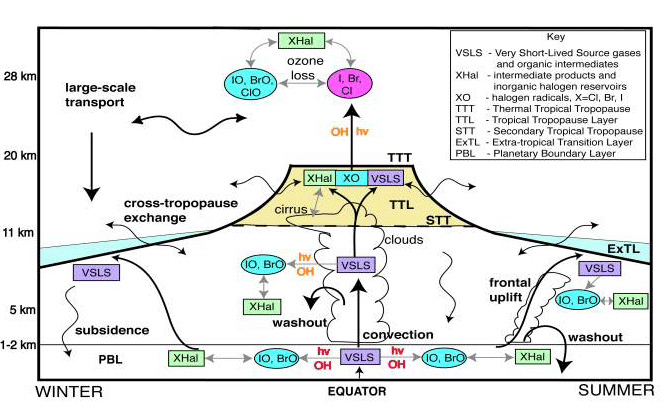
SPARC
Stratospheric Processes And their Role in Climate
A core project of the World Climate Research Programme
Publications (Newsletters / Reports)
S P A R C Themes
1 - Climate-Chemistry Interactions
- How will stratospheric ozone and other constituents evolve?
- How will changes in stratospheric composition affect climate?
- What are the links between changes in stratospheric ozone, UV radiation and tropospheric chemistry?
Theme leaders: T. Peter (Switzerland), A. R. Ravishankara (USA)
Many agents force Earth’s climate. Changes in these agents can perturb the climate significantly. Atmospheric chemistry plays a critical role in the perturbation of climate by controlling the magnitudes and distributions of a large number of important climate forcing agents. For example, abundances and distributions of water vapour and ozone in the stratosphere depend critically on the atmospheric chemistry. Similarly, the abundances of methane and tropospheric ozone also depend on atmospheric chemical processes.
According to IPCC (2001), methane and ozone are the second and third most important greenhouse gases that have increased due to anthropogenic activities since the industrial revolution. Changes in tropospheric composition alters the stratospheric composition via changes in the input to the stratosphere. Similarly, changes in the stratosphere affects the troposphere via changes in the input of UV radiation and also of ozone from the stratosphere (Figure 1).

|
Figure 1. Coupling between forcings. The interconnections between various forcing emerge as indirect effects or feedbacks through various processes. Chemical processes are one of major pathways for the interconnections. The arrow indicates the coupling between forcing brought about by various pathways including chemical and dynamical processes. The changes in the radiative forcing, since industrialisation, shown in the figure are due to various emissions as noted by IPCC (2001). Understanding and quantifying these chemical and dynamical processes is at the heart of this theme. (From Ravishankara, 2004; adopted from IPCC 2001). For better resolution, please contact the SPARC Office |
Aerosol is another climate forcing agent. Effects of anthropogenic aerosols on the climate has a potential to cancel the increased radiative forcing of greenhouse gases since industrialisation. Aerosols can perturb atmospheric radiation through a direct effect of scattering and absorption of radiation. Stratospheric aerosols greatly alter the chemistry in that region and lead to such spectacular changes as the Antarctic ozone hole, with consequences to climate. The effects of aerosols depend critically on their chemical composition and mixing state. Aerosols can also have an indirect effect via interaction with clouds (water, ice and cirrus clouds) by acting as Cloud Condensation Nuclei (CCN). Further, clouds can modify aerosols, their optical properties, their size distributions and their ability to act as CCN. The indirect effect, which is a strong function of chemical and physical properties of aerosols, can perturb clouds and even the hydrological cycle, two pivotal components of the climate system (Figure 2).
 |
Figure 2. Change in climate alters composition. The figure shows the changes in ozone abundances as a function of time for different Arctic late-winter/early-spring conditions. These conditions, such as the PSC loading, are altered by the abundances of water vapour and nitric acid, as well as temperature. Future climate change will alter the stratospheric composition and temperature, which in turn will alter the ozone levels in this region. Understanding the impact of climate changes on composition and dynamics is another major emphasis of this theme. (From Chipperfield, 2004). For better resolution, please contact the SPARC Office |
Changes in climate also affects the atmospheric chemistry, and hence the atmospheric composition, significantly. For example, a change in water vapour can perturb the oxidation capacity of the atmosphere. Changes in stratospheric temperature and water vapour can alter the ozone abundance. They can for example alter the expected recovery of the ozone layer. A change in temperature or relative humidity can change the chemical and physical properties of aerosols. These interactions and feedback processes are complex and poorly understood. Therefore, a clear understanding of the processes acting in the climate system are essential. In case of short-lived species, because of their variability in space and time, even the current contributions to the climate forcings cannot be easily evaluated via their atmospheric observations alone but requires modeling of the relevant processes. Currently, there is a great deal of emphasis on the short-lived species because of the possibility of a quick “return” upon some policy action. Furthermore, these short-lived species are the “pollutants” that need to be addressed for human health and other concerns. Therefore, clear understanding of the processes that connect emissions (source, precursors) to abundances and the processes that connect the abundances to the climate forcings is essential for an accurate prediction of the future climate and an assessment of the impact of climate change and variations on the earth system (Figure 3).
 |
Figure 3. The key role of Tropical Tropopause Layer (TTL). This diagram depicts the various processes and regions involved in the chemistry and dynamics of TTL. Studying this region is an example of the kind of activities being undertaken in this theme. (From Cox and Haynes, 2003; from Scientific Assessment of Ozone Depletion: 2002, WMO report No.47). For better resolution, please contact the SPARC Office |
To assess the current state of our understanding on some of the key issues related to climate-chemistry interactions, a joint SPARC-IGAC (International Global Atmospheric Chemistry project, one of International Geosphere-Biosphere Program’s (IGBP) core project) workshop was held in Giens, France, during 3-5 April 2003. The outcome of this meeting forms part of the plan for SPARC’s theme on Climate-Chemistry Interactions. Examples of activities to be included in this theme are the quantification of ozone transport from the stratosphere to troposphere, chemistry and dynamics of the Tropical Tropopause Layer (TTL), and the chemical and dynamical processes that contribute to lower stratospheric ozone change.
Go to: "Detection, Attribution, and Prediction of Stratospheric Change"
Go to: "Stratosphere-Troposphere Dynamical Coupling"
Last update : August 26, 2005
